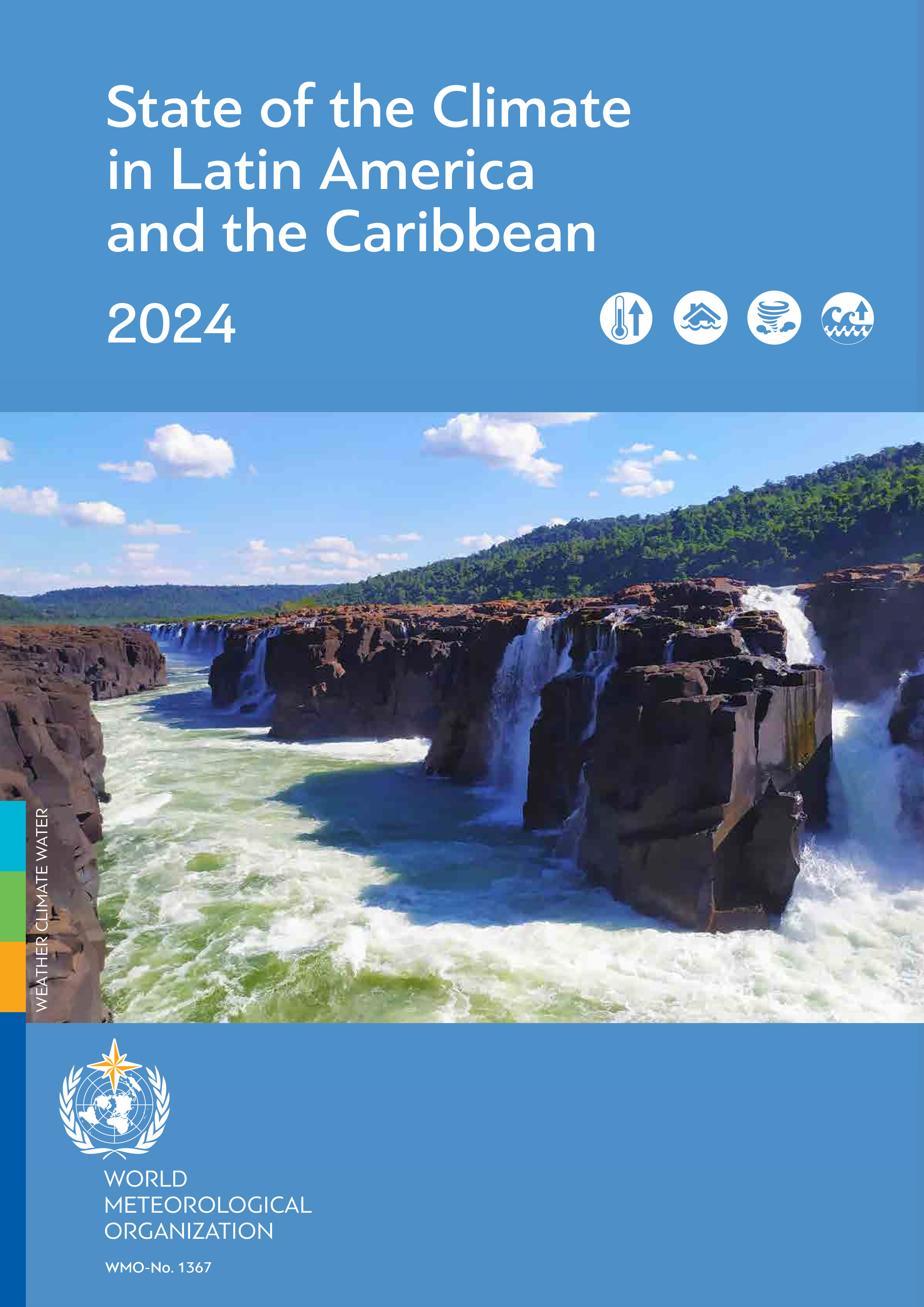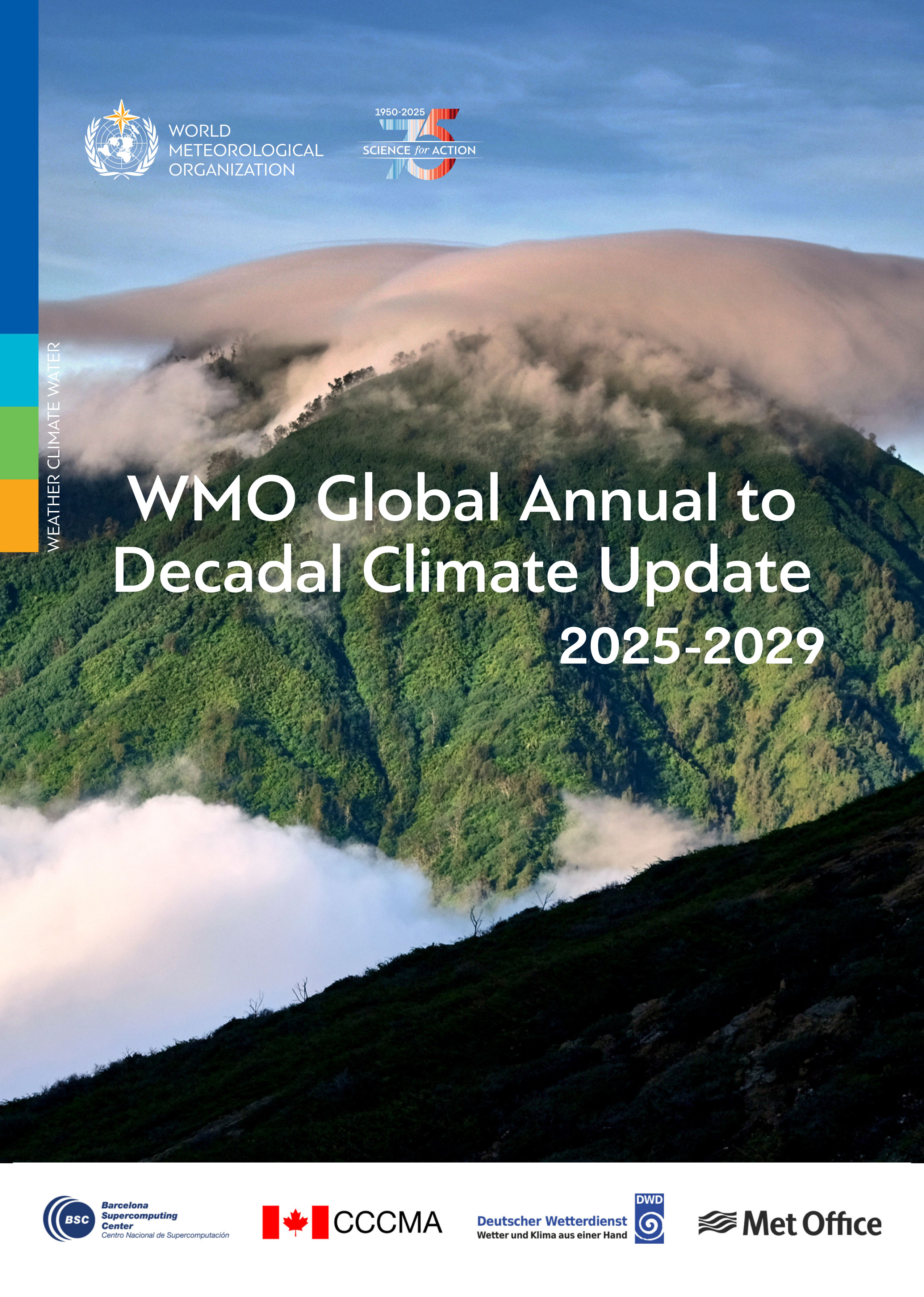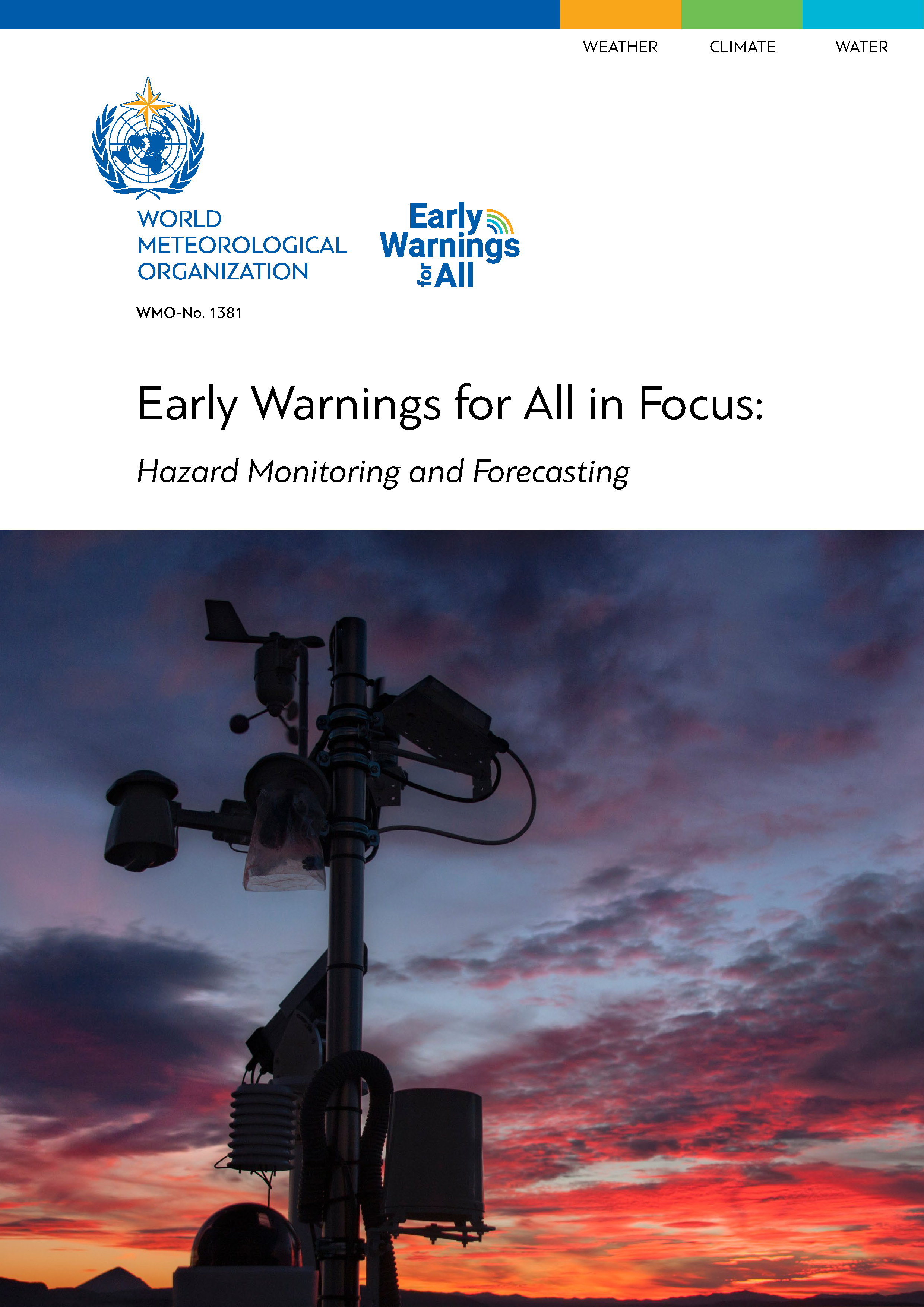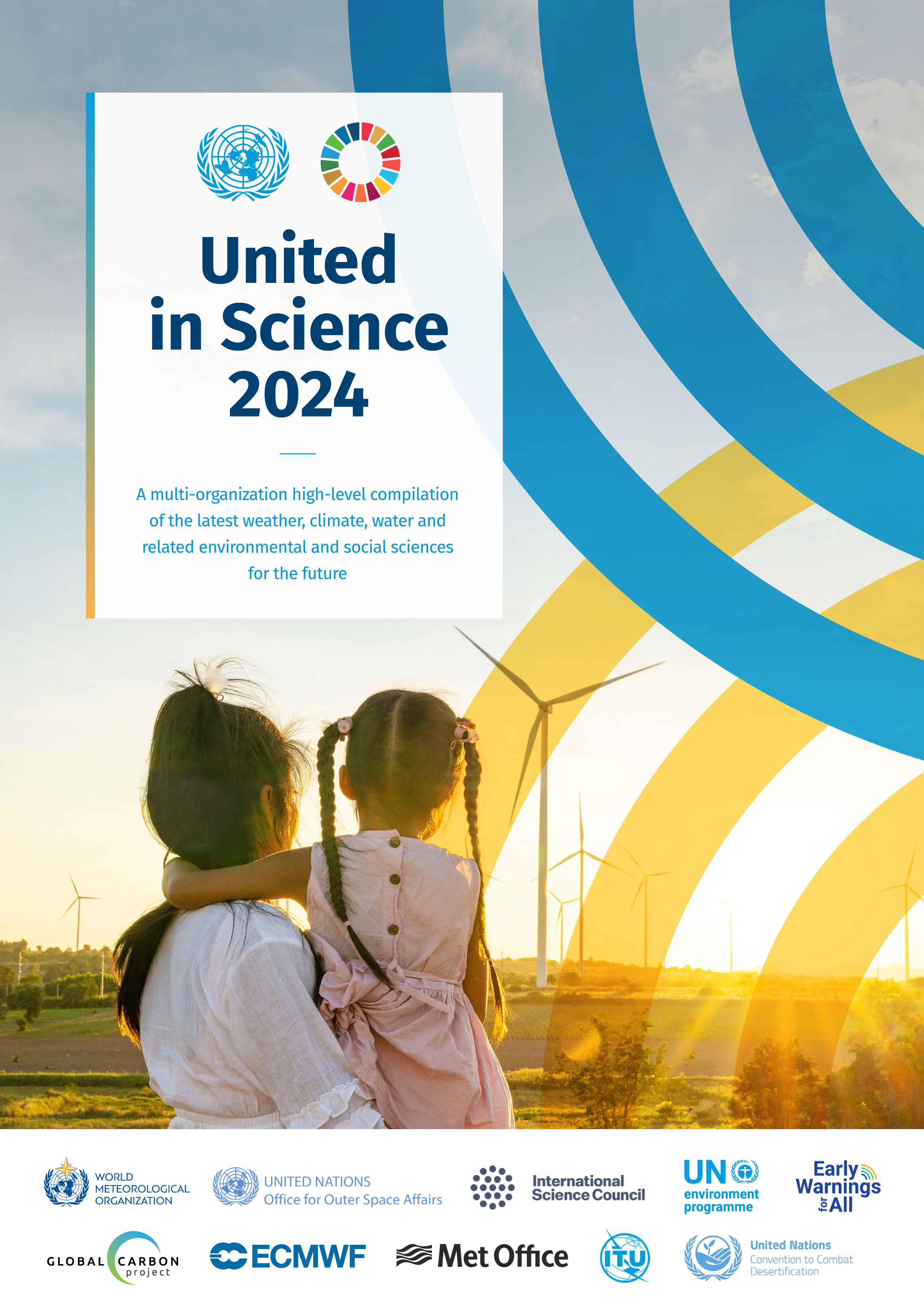Climate Change

Collection Contents
16 results
-
-
2024 State of Climate Services
Five-year Progress Report (2019–2024)
More LessAs climate change impacts intensify, the need for climate services to support mitigation, adaptation and increase resilience has never been higher. In the past five years, there has been progress in provision of this climate information for decision-making, but big gaps remain and investment lags far behind need. The State of Climate Services report says that in 2024, one third of National Meteorological and Hydrological Services (NMHSs) provide climate services at an ‘essential’ level, and nearly one third at an ‘advanced’ or `full’ level. It says that countries in Asia and Africa, in particular, have made strides in boosting their capacity thanks to targeted adaptation funding. The report highlights that 2023 was the warmest year on record to date, with the unprecedented warmth continuing into 2024. Many climate extremes are becoming more frequent and intense. While weather and climate-related reported deaths are decreasing over time due to better early warnings and disaster risk management, economic losses are increasing. The latest edition of the report explores the current state of play and also documents the progress that has been made in the last five years. It includes analyses and stories to explain how specific countries, including Seychelles, Mauritius, Laos, and Ireland, have succeeded in developing and using climate services to deliver a range of socioeconomic benefits and to advance climate action. The report is based on contributions from 38 partners including major climate finance institutions, such as the Green Climate Fund, Adaptation Fund and the Global Environment Facility that are founding partners of the report series, and the UNFCCC Secretariat. The UN Office for Disaster Risk Reduction worked closely with WMO on the Investment section of this year's edition.
-
-
-
State of the Global Climate 2024
More LessThe publication provides a summary on the state of the climate indicators in 2024 with sections on key climate indicators, extreme events and impacts. The indicators include global temperatures, greenhouse gas concentration, ocean heat content, sea level rise, ocean acidification, Arctic and Antarctic Sea ice, Greenland ice sheet and glaciers and snow cover, precipitation and stratospheric ozone, with an analysis of major drivers of inter-annual climate variability during the year including the El Niño Southern Oscillation and other ocean and atmospheric indices. The highlighted extreme events include those related to tropical cyclones and windstorms, flooding, drought and extreme heat and cold events. The publication also provides most recent finding on climate related risks and impacts including on food security and population displacement.
-
-
-
European State of the Climate 2024
More LessEurope is the fastest-warming continent, and the impacts of climate change are clear. 2024 was the warmest year on record for Europe. Storms were often severe and flooding widespread, claiming at least 335 lives and affecting an estimated 413 000 people. During the year, there was a striking east-west contrast in climate conditions, with extremely dry and often record-warm conditions in the east, and warm but wet conditions in the west. The European State of the Climate 2024 (ESOTC 2024) report involves around 100 scientific contributors providing holistic yet concise insights into Europe’s climate. C3S is implemented by the European Centre for Medium-Range Weather Forecasts on behalf of the European Commission. Since 2018, the service has released the ESOTC, a detailed analysis of Europe’s climate for the previous year, going beyond annual temperature with analyses of a wide range of climate variables, from heat and cold stress to sunshine duration and cloudiness, from wildfires to glaciers and much more.
-
-
-
State of the Climate in Africa 2024
More LessThe State of the Climate in Africa 2024 report reveals that extreme weather and climate change are intensifying hunger, insecurity, and displacement across Africa, impacting every facet of socio-economic development. 2024 ranked as one of the warmest years on record, with unprecedented sea-surface temperatures and widespread marine heatwaves. The report outlines severe challenges for agriculture, food and water security, health, and education—while also highlighting emerging opportunities through AI, mobile tools, and advanced weather models. It calls for urgent investment in infrastructure, data sharing, and inclusive services to strengthen early warning systems and climate resilience.
-
-
-
State of the Climate in Asia 2024
More LessThe WMO’s State of the Climate in Asia 2024 report says that 2024 was the warmest or second warmest year on record (depending on the dataset), with widespread and prolonged heatwaves. The warming trend between 1991–2024 was almost double that during the 1961–1990 period. In 2024, heatwaves gripped a record area of the ocean. Sea surface temperatures were the highest on record, with Asia’s sea surface decadal warming rate nearly double the global average. Sea level rise on the Pacific and Indian Ocean sides of the continent exceeded the global average, heightening risks for low-lying coastal areas. Reduced winter snowfall and extreme summer heat were punishing for glaciers. In the central Himalayas and Tian Shan. 23 out of 24 glaciers suffered mass loss, leading to an increase in hazards like glacial lake outburst floods and landslides and long-term risks for water security. Extreme rainfall wreaked havoc and heavy casualties in many countries in the region, and tropical cyclones left a trail of destruction, whilst drought caused heavy economic and agricultural losses. The report included a case study from Nepal, showing how strengthened early warning systems and anticipatory action enable communities to prepare for and respond to climate variability and change, thereby helping to protect lives and livelihoods. The State of the Climate reports are flagship reports of WMO and provide policy-relevant information for national and regional decision-making.
-
-
-
State of the Climate in Latin America and the Caribbean 2024
More LessThe WMO State of the Climate in Latin America and the Caribbean 2024, is the fifth edition of climate reports published annually for this region and has involved National Meteorological and Hydrological Services (NMHSs), WMO Regional Climate Centres (RCCs), and several research institutions, as well as United Nations agencies, international and regional organizations. The report provides the status of key climate indicators and latest data and information on impacts, risks and policy from United Nations agencies. It addresses specific physical science, socio-economic and policy aspects that are relevant to LAC and responds to Members needs in the fields of climate monitoring, climate change and climate services.
-
-
-
State of the Climate in the South-West Pacific 2024
More LessThe World Meteorological Organization’s State of the Climate in the South-West Pacific 2024 report warns that unprecedented ocean warming, sea level rise, and extreme weather are endangering lives, ecosystems, and economies across the region—especially in coastal and island communities. 2024 saw record sea-surface temperatures and near-record ocean heat content, with marine heatwaves affecting over 10% of the global ocean. On land, extreme heat, intense rainfall, and a historic cyclone season caused devastating impacts, while Indonesia’s last tropical glacier nears extinction. The report highlights the importance of strengthened early warning systems, featuring success stories from the Philippines and Fiji that demonstrate how anticipatory action and community-led responses can protect lives and preserve cultural heritage. It calls for urgent investment in adaptation, early warnings, and climate-resilient development.
-
-
-
WMO Global Annual to Decadal Climate Update
Target Years: 2025 and 2025-2029
More LessThe Global Annual to Decadal Climate Update is issued annually by the World Meteorological Organization (WMO). It provides a synthesis of the global annual to decadal predictions produced by the WMO designated Global Producing Centres and other contributing centres. Last year, 2024, was the warmest year on record, with the globally averaged near-surface temperature estimated at 1.55°C ±0.13°C above the 1850–1900 baseline. Near-surface temperatures in 2024 were warmer than the long-term average almost everywhere over land with particularly large warm anomalies in the tropics, North America, North Africa, Europe and parts of Asia. Annually averaged global temperatures are likely to continue at or near record levels in the five-year period 2025-2029 and stay well above annual mean temperatures seen in the last 60 years. Annually averaged global mean near-surface temperature for each year in this five-year period is predicted to be between 1.2°C and 1.9°C (90% confidence interval) higher than the average for the period 1850-1900.
-
-
-
State of Global Water Resources 2024
More LessThe 2024 edition of the State of Global Water Resources report documents an extraordinary year shaped by record heat, climate extremes, and widespread water-related impacts. With global surface temperatures reaching 1.55 °C above pre-industrial levels, 2024 was the hottest year in the 175-year observational record. Strong El Niño conditions at the start of the year amplified drought in South America and southern Africa, while other regions faced devastating floods. Across the water cycle, extremes were evident: rivers, reservoirs, lakes, groundwater, and glaciers all showed significant departures from normal. While parts of Africa, Europe, and Asia were inundated by flooding, South America and southern Africa endured severe drought. Glaciers continued record ice loss, adding to sea level rise. These events brought widespread human and economic costs, underscoring the urgent need for better monitoring, early warning, and adaptive water management in the face of a warming climate.
-
-
-
State of the World’s Indigenous Peoples
Climate Crisis
More LessThis sixth volume of the State of the World’s Indigenous Peoples focuses on the climate crisis, its impact on Indigenous Peoples, and the role Indigenous Peoples can and do play in mitigating the effects of climate change. It aims to provide a comprehensive overview of current and emerging issues in the context of the climate crisis from the perspective of Indigenous Peoples. Drawing on illustrative examples from across the seven sociocultural regions, the publication highlights both challenges and good practices linked to Indigenous Peoples’ experiences with and responses to the ongoing climate crisis. Ultimately, this report is intended to serve as an authoritative reference and advocacy tool for Indigenous Peoples and civil society organizations and to contribute to the broader conversation around climate change mitigation, adaptation and resilience.
-
-
-
Early Warnings for All in Focus: Hazard Monitoring and Forecasting
More LessLaunched by the United Nations Secretary-General at the 27th Conference of the Parties (COP27) to the United Nations Framework Convention on Climate Change (UNFCCC) in 2022, the Early Warnings for All (EW4All) initiative set a clear and ambitious goal: that every person on Earth be protected by life-saving, multi-hazard early warning systems by 2027. Grounded in national leadership and country driven priorities, the initiative unites governments, civil society, the private sector and development partners. Within the United Nations system, it is co-led by WMO, the United Nations Office for Disaster Risk Reduction (UNDRR), the International Telecommunications Union (ITU), and the International Federation of Red Cross and Red Crescent Societies (IFRC), ensuring coordinated international support behind a single imperative: to reduce the impact of hazardous weather and disasters through science-based early warning and early action.
-
-
-
Green Finance and Decarbonization of Petrochemicals
Slim Pickings in a Crucial but Hard-to-abate Industry
More LessThe petrochemical industry is a little studied but crucial sector that needs to rapidly ramp up its climate ambition if it is to align with the SDGs and contribute to the objectives of the Green New Deal. The implications of not doing this are significant, both in terms of the environment (petrochemicals being a major producer of carbon emissions, chemical pollutants and plastic), and in terms of potentially provoking financial and economic instability and “climate Minsky” shock. This paper builds on a previous study by the authors that analysed thousands of financial transactions to identify the respective roles played by public and private banks, bond markets and other sources of capital in this sector. This paper now digs deeper into so-called “green” finance and, in particular the market-based mechanism of green bonds. It draws on empirical evidence from global financial databases and development banks, and from case-study analysis of two development-bank financed green bond issues to the petrochemical sector. Both issuances are in Asia, the world’s manufacturing hub and driving force behind increased petrochemicals production and facilities. Lessons learned here are extremely relevant for the climate change debate, as the region is at the forefront where impact will be greatest in the near-term. This paper finds that “green finance” is at best marginal, so that significant chances are needed in the provision of finance to the petrochemical industry, if it is to influence the region’s green transition and meeting the goals of Agenda 2030. Market mechanisms still offer only the slimmest pickings, making it likely that dedicated public financial institutions such as public banks will be required for any major investment push.
-
-
-
Global Assessment Report on Disaster Risk Reduction 2025
Resilience Pays: Financing and Investing for our Future
More LessThe Global Assessment Report (GAR) 2025: Resilience Pays: Financing and Investing for our Future highlights how smarter investment can reset the destructive cycle of disasters, debt, uninsurability and humanitarian need that threatens a climate-changed world. Disaster risk is increasing as more frequent and intense hazard events, unsafe urbanization and ineffective development put more people and assets in harm’s way. Disasters are having profound macroeconomic impacts, with direct losses estimated at $202 billion. When indirect and ecosystem costs are taken into account, escalating disaster costs now surpass $2.3 trillion annually. There is an urgent need to transform how disaster risk is addressed amid a rapidly changing climate. Risk is no longer a peripheral issue but a systemic challenge that affects financial stability, sustainability, and equity. By embedding risk reduction into core policy and investment decisions, it is possible to break the recurring cycle of shocks, losses and debt. With the right choices, resilience can become a foundation for long-term prosperity, enabling societies not only to withstand disasters but to thrive despite them.
-
-
-
Report of the Secretary-General on the Work of the Organization 2025
For Humanity
More LessAuthor: United NationsThe Report of the Secretary-General on the Work of the Organization (A/80/1) is issued in response to Article 98 of the UN Charter and highlights how the UN Secretariat translates resources into impact. The Report covers nine sections: (i) forging pathways for sustainable development; (ii) fostering peace and security; (iii) propelling African growth; (iv) upholding human rights; (v) securing humanitarian assistance; (vi) advancing justice and international law; (vii) championing disarmament; (viii) combating drugs, crime and terrorism; and (ix) enhancing our operations. The e-book for this publication has been converted into an accessible format for the visually impaired and people with print reading disabilities. It is fully compatible with leading screen-reader technologies such as JAWS and NVDA.
-
-
-
The Sustainable Development Goals Report 2025
More LessThe Sustainable Development Goals Report 2025 marks the tenth annual stocktaking of global progress toward the 2030 Agenda for Sustainable Development. With the 2030 deadline only five years away, the report delivers a stark assessment: the Sustainable Development Goals have improved millions of lives, but the current pace of change is insufficient to fully achieve all the Goals by 2030. The report reveals real and substantial development gains during the past decade. Since 2015, the world has made notable strides in expanding access to education, improving maternal and child health, and bridging the digital divide. Effective prevention efforts have significantly reduced the burdens of infectious diseases such as HIV and malaria. Access to electricity has continued to grow, and renewable energy is now the fastest-rising source of power worldwide. Yet progress has been fragile and unequal. Millions still face extreme poverty, hunger, inadequate housing, and a lack of basic services. Women, people with disabilities, and marginalized communities continue to face systemic disadvantages. Escalating conflicts, climate chaos, rising inequalities, and soaring debt servicing costs are holding back further advancements. Despite these setbacks, national and local success stories showcased in the report – such as universal electricity access in 45 countries and the elimination of neglected tropical diseases in 54 countries – demonstrate that accelerated progress is not only possible but already happening. The report calls for action in six priority areas: food systems, energy access, digital transformation, education, jobs and social protection, and climate and biodiversity. It also urges increased international cooperation and sustained investment to turn the ambition of the 2030 Agenda into reality.
-
-
-
United in Science 2024
A Multi-organization High-level Compilation of the Latest Weather, Climate, Water and Related Environmental and Social Sciences for the Future
More LessThe science is clear – greenhouse gas emissions are rising, global temperatures are shattering records, and extreme weather is wreaking havoc with our lives and our economies. Urgent and ambitious action is needed to support sustainable development, climate action and disaster risk reduction. The decisions we make today could mean the difference between a future of breakdown or a breakthrough to a better world for people and the planet. United in Science 2024 emphasizes the transformative impact of new technologies and innovative approaches across weather, climate, water and related environmental and social sciences. From artificial intelligence (AI) to cutting‑edge satellite technologies and virtual realities that bridge the physical and digital worlds, scientific and technological advances are enhancing weather, climate, water and related environmental applications as well as informing strategies for responding to global challenges such as climate change and sustainable development. The report also underscores the necessity of transdisciplinary approaches that help apply science and technology in local contexts and boost their impact by embracing diverse knowledge, perspectives and experiences to co-develop and implement solutions. While significant gaps and challenges remain, enhanced collaboration across scales is essential to harness the full potential of weather, climate, water and related environmental and social sciences to ensure that their benefits are accessible to all.
-
















